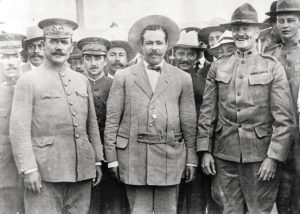Chicano folklore author Americo Paredes just might be a patron saint of Mexican-American empowerment. Unhappy about how Mexican Americans were being treated and often tormented by Anglo Americans, he began to write about it in a descriptive and moving way in the 1950s. Paredes today inspires others to hear and feel the border tension and cultural differences in his writings. The topics of his many books have been about “The Chicano Movement” that struggles to be heard from the oppressed Mexican Americans dating back to the Treaty of Hidalgo of 1848. Paredes’ book With a Pistol in His Hands helped shine a light on a corrido “border ballad” that he grew up hearing as a young boy. Americo Paredes’s work was written before the civil rights activism of the 1960s, Americo often claims that the 1960s promoted his works, showing the struggles of the Mexican Americans before the change took place, which promoted Americo as a writer. Paredes’s writings all reflect the common human needs and concerns of Mexican Americans, making him a recognized leading scholar of Mexican-American and Chicano folklore.
Paredes dreamed of being a professor, despite thirty-five years of difficult roads he faced in his young life. He enrolled at the University of Texas in Austin to complete his bachelor’s degree in 1951, then continued to earn his masters degree in 1953, and completed his doctors degree in 1956. The subject of his dissertation focused on the Corrido of Gregorio Cortez, a Texas American folk hero. Paredes made the decision to find the truth about this controversial character. He commented, “I was very much aware… I was not the only one who believed that what we were taught in school at the time and what we knew in our hearts and what our parents told us was different than our heritage was not given the respect that it deserved. The thing was that most of what people knew was in corridos, in legends, and in oral history. And I wanted to bring these things to the majority.”1

The Corrido of Gregorio Cortez is about a Texas-Mexican folk hero who lived at the turn of the twentieth century. Cortez was born on June 22, 1875, on a border ranch between Matamoros and Reynosa in Tamaulipas, Mexico. He and his brother Romualdo were farming a piece of rented land near Kenedy in Karnes County, Texas. Sheriff Morris and two deputies rode to the pursuit of a horse thief, eventually leading to the Cortez property. Since the sheriff spoke no Spanish, he relied primarily on his deputies as translators. The translator wasn’t proficient in Spanish either, and there was a translation error involving the Spanish word for a “mare.” The sheriff shot his brother and tried arresting Gregorio. Gregorio Cortez then shot and killed Sheriff Morris out of self-defense and soon fled, knowing that he would not get a fair trial in that region of Texas, due to his killing a law enforcer as well as the general prejudice against Mexican Americans in the region.2
Paderes proposed that the border folk along the lower Rio Grande region not only preserved the best qualities of the Spanish ballad tradition, but also took it to another level when they began to sing of themes related to cultural conflicts.3 Paredes’s biographer Manuel Medrano writes, “He encountered during his research that Mexicans along the border who helped Cortez with water or food were severely beaten or hanged. His mother, as well as his family, were harassed and jailed. An innocent thirteen-year-old Mexican boy was hung because he was believed to be in a gang of Cortez, which did not exist. All of this injustice was done with over one hundred men consisting of Texas Rangers, sheriffs, and posses during their search for Cortez.”4
“Paredes’s research uncovered cultural differences that did not put the Texas Rangers in a good light, along with another folklorist Walter Prescott Webb. Paredes researched the corrido from the Mexican-Texan view, not the Anglo-Texan view.”5 Paredes showed us why and how oppressed people go immediately to the very mechanism that has been used to ridicule and dehumanize them in order to turn them around.
![Caption: Company D, Texas Rangers, Frontier Battalion, Ysleta, Texas, 1894 --- Reading left to right [standing]: Dep. U.S. Marshal F.M. McMahon; Vn. Schmidt; James V. Latham; Joe Sitter; Ed Palmer; T.T. Cook; Sitting: Mexican prisoner; George Tucker; J.W. Saunders; Seargt. Carl Kirchner and Captain John R. Hughes.](http://upload.wikimedia.org/wikipedia/commons/a/aa/Texas_Rangers_Company_D_1894.jpg)
A visiting professor, Stith Thompson from Indiana University and head of the folklore program there, helped sway the approval of the dissertation committee. “He championed Paredes’ work on a campus that had not been known for enthusiasm toward Mexican-American scholars or students.”8 Professor Thompson then suggested to Paredes that his manuscript be sent to the University of Texas Press to be published.
The director of the University of Texas Press appreciated the manuscript that was sent to them for approval. He would approve the publication of the manuscript with the condition that edits be made to it before they could approve it. Commenting on the requested edits, Paredes remarked, “Most of the changes targeted comments made about J. Frank Dobie, Walter Prescott Webb, and the Texas Rangers, in addition to suggesting that the manuscript be shortened by one-fourth to one-third.”9 Paredes did reflect on the suggestions that were made toward his work before he responded to them about the publication of the manuscript. Paredes didn’t make the edits suggested, but instead, after negotiations with the University of Texas Press, it was approved to be published. Paredes later said that if he had accepted all of their suggestions, “there would be nothing left but a pretty story.”10
The sales of the book had a slow start. It took about ten years to see royalties, since one thousand books needed to be sold before he would see a penny. Paredes recalled that when his book was published, “Chicano literature, as such, did not exist, but there was a great deal of writing being done by both Mexicans who had moved to the United States and native Texas Mexicans, which at the time was not recognized… What made the difference was that they write in Spanish and did not have the impact they might have had had they been written in English.”11

Ten years after the book was published, the sales increased dramatically. The Chicano Movement in California led Chicanos to embrace the book when they discovered it. Many of the Chicanos in Texas heard of the book and started to purchase and read the book as well. According to a colleague of Paredes’s, his assumption of the “conflict–cultural, economic, and physical” has always “been a way of life along the border between Mexico and the United States.”12 Many Chicanos believed the book was important to the movement.
The comments and reviews for With His Pistol in His Hands were generally positive. George I. Sanchez, a professor in the Education Department at the University of Texas at Austin and author of The Forgotten People, wrote a letter to the press’ director Frank Wardlaw. Sanchez called it “a beautiful work, … a courageous work of Paredes and of the Press. I congratulate both. It is too, a constructive pioneer job that can lead to spectacular enrichment of Texas culture… This opens horizons in Texas culture only dimly explored in the literature.”13
It was evident that Paredes’ persistence and exhaustive work on the book With His Pistol in His Hands were being recognized in the states. Americo Paredes continued to write throughout the rest of his life literature that reflected the life around the border.
- Manuel Medrano and Americo Paredes, Americo Paredes: In His Own Words, an Authorized Biography (Denton, Tx: University of North Texas Press, 2010), 44. ↵
- Manuel Medrano and Americo Paredes, Americo Paredes: In His Own Words, an Authorized Biography (Denton, Tx: University of North Texas Press, 2010), 45. ↵
- Jose R. Lopez Morin, The Legacy of Americo Paredes (Rio Grande/Rio Bravo College Station: Silver Lining Books, 2006), 78. ↵
- Manuel Medrano and Americo Paredes, Americo Paredes: In His Own Words, an Authorized Biography (Denton, Tx: University of North Texas Press, 2010), 43. ↵
- Angie Chabram-Demersesian, The Chicana/o Cultural Studies Forum (New York: New York University Press, 2007), 196. ↵
- Hector Calderon, Narratives of Greater Mexico: Essays on Chicano Literary History (Austin: University of Texas Press, 2004), 26. ↵
- Manuel Medrano and Americo Paredes, Americo Paredes: In His Own Words, an Authorized Biography (Denton, Tx: University of North Texas Press, 2010), 53. ↵
- Manuel Medrano and Americo Paredes, Americo Paredes: In His Own Words, an Authorized Biography (Denton, Tx: University of North Texas Press, 2010), 43. ↵
- Manuel Medrano and Americo Paredes, Americo Paredes: In His Own Words, an Authorized Biography (Denton, Tx: University of North Texas Press, 2010), 43. ↵
- Manuel Medrano and Americo Paredes, Americo Paredes: In His Own Words, an Authorized Biography (Denton, Tx: University of North Texas Press, 2010),44. ↵
- Manuel Medrano and Americo Paredes, Americo Paredes: In His Own Words, an Authorized Biography (Denton, Tx: University of North Texas Press, 2010), 45. ↵
- Shelley Fisher Fishkin, Writing America: Literary Landmarks from Walden Pond to Wounded Knee (New Brunswick, New Jersey: Rutger University Press, 2015), 325. ↵
- Manuel Medrano and Americo Paredes, Americo Paredes: In His Own Words, an Authorized Biography (Denton, Tx: University of North Texas Press, 2010), 45. ↵




10 comments
Emilia Caballero Carmona
Hey Anthony, your article was so interesting to read! Personally, I had never heard about Americo Paredes, but his story is such an inspiration to me and my culture. I was so happy to read that he was dedicated on bringing awareness to the racial discrimination Mexican Americans were facing at that time and that he dedicated his work to helping the Chicano movement which is so important in the United States.
Nicolas Llosa
I really liked reading about this article because it introduced me to Americo Paredes and learned about what Mexican Americans went through. Americo Paredes’ work was remarkable and important for the empowerment of Mexican Americans, as well as it gave importance and made noticeable a problem that many people may have overlooked. I enjoyed learning about this since I learned new stories of people and learned something I had never been taught before.
Keily Hart
This was a really well written and informative article. I had never heard of Americo Paredes, but to hear about this influential Mexican American. I appreciated this window into a culture and history that I have very little connection to otherwise. I enjoyed learning about his activism and many great achievements in this fantastic article. Americo Paredes was truly a super important in Mexican American empowerment.
Micheal Baladez
Growing up within a primarily latino city, finding this article makes me appreciate individuals who dedicate their time towards writing, get involved with, or studying Mexican History to bring out whatever topics that seemingly get swept under the rug. Within society, Mexicans are oftentimes viewed as second-class citizens who aren’t necessarily the sharpest tools in the shed. However, once those individuals learn of the richer, deeper side of the history behind the heritage, they begin to see how truly intelligent many Mexicans are, alongside how they have left their permanent mark in history. Embracing the fact that they are people too, the Chicano movement was an important event in Mexican-American history, giving a voice to those who were never really thought to have one. All things considered, it is quite a shame how Mexican and Latino history is not a subject taught more often within our education system. Tremendous props for the article.
Genesis Vera
It is refreshing to hear about Americo Paredes. I appreciate the description of who Americo Paredes is and what his big accomplishments were because it allowed me to understand what the main purpose of the article was going to be. As a Mexican- American myself, I was able to relate to Americo Paredes and the hardships he faced. Overall, I really enjoyed this article and the description of this activist.
Angela Perez
This article brings to light an important figure in telling the story of the life Mexican Americans in Texas in the 1900’s. These stories are not in our history books and are overlooked when it comes to the mistreatment of Mexican Americans, the harsh treatment, and the discrimination that was occurring across the state. Bringing in the story of Cortez gave interesting insight to what an encounter with the sheriff’s really was like. I appreciated the connection between his story, his corrido, and Paredes.
Aleea Costilla
I enjoyed reading this article as I was able to learn more about the author of a book I had just recently read titled “George Washington Gomez.” Understanding Americo Paredes’ background put the context of his work in perspective as he was able to integrate his Mexican heritage into literature. The Corrido of Gregorio Cortez is a vivid example of Mexican Americans’ realities during the early 1900s and rightfully so exposed the unjust history of Texas Rangers. His resilient qualities have opened the door for Mexican authors in literature and the inclusion of the Mexican perspective.
Maria Obregon
What a great article! I am Mexican-American and I had never heard of Americo Paredes until now. I had also not heard of Gregorio Cortez and what happened to his family, nor what was done to people who helped him. What the Texas Rangers, sheriffs, and others did to these people during their search for Cortez was so inhumane and unjust. I do not understand how they had the heart to do those horrible things. Reading this article made me realize even more how so much of our history is hidden, although it should not be. Mexican-American history should be taught in schools, especially in places that have a large Mexican-American population.
Abilene Solano
I learned so much from reading this article because it introduced me to a person who played an important role in ‘Mexican-American empowerment’. You do not usually learn about many Mexican/Chicano figures in your history class which is sad because they are the key reasons as to why we had so many movements all focused on empowerment and equality. As a Mexican American, I find it disheartening that there is so little information being taught about Mexican/Chicano history in our schools, it is such an enriched and beautiful culture that not many people recognize. I truly enjoyed this article because it taught me about someone that I have never learned about at all, I really liked how in depth the author went in about the sufferings Mexicans went through and explained how Americo Paredes became the “patron saint of Mexican American empowerment”.
Lulu Guadalupe Avitua-Uviedo
I appreciate this article because many who write, get involved or study Mexican History bring out what little is spoken or taught about. Mexicans are viewed as second class citizens but when they learn there is more history behind the heritage they learn how intelligent many are and how they have left a print in history. The Chicano Movement was a strong voice to let everyone know, Mexican’s are important people too. Like the Walk out In Christal City and so many other awareness and protest was to voice who we are. It’s a shame that to this day, Mexican American studies are not taught in all the schools. Thank you for this article.